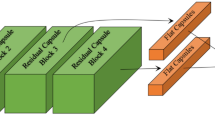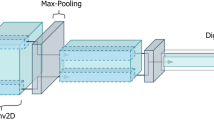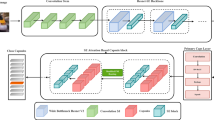Abstract
Scalar neural network algorithms are limited in their ability to understand scale, rotational, or affine transformations within images and resort to average or max-pooling techniques which result in translational invariance. In an attempt to overcome these limitations, Hinton et al. introduced vectorized capsule network frameworks which support equivariance while capturing spatial relationships between data points, thus enhancing predictive capabilities of networks. However, experimenting with activation functions, hyperparameters, and optimizers have proven faster convergence and orthogonalizing weights within the layers of capsules enhance performance by slashing associated average error rates.
Access this chapter
Tax calculation will be finalised at checkout
Purchases are for personal use only
Similar content being viewed by others
References
Sabour S, Frosst N, Hinton G (2017) Dynamic routing between capsules. In: Thirty first conference on neural information processing systems. arXiv:1710.09829
Hinton G, Sabour S, Frosst N (2018) Matrix capsules with EM routing. In: International conference on learning representations
Pascanu R, Mikolov T, Bengio Y (2013) On the difficulty of training recurrent neural networks. In: International conference on machine learning, pp 1310–1318
Dauphin Y et al (2014) Identifying and attacking the saddle point problem in high dimensional non convex optimization. In: Advances in neural information processing systems, pp 2933–2941
Ioffe S et al (2015) Batch normalization: accelerating deep network training by reducing internal covariance shift. In: International conference on machine learning, pp 448–456
Bansal N, et al (2018) Can we gain more from orthogonality regularizations in training Deep CNN’s? In: Advances in neural information processing systems. arXiv:1810.09102
Balestriero R et al (2018) Mad max: affine spline insights into deep learning. arXiv:1805.06576
Zhu Z et al (2019) A convolutional neural network based on a capsule network with strong generalisation for bearing fault diagnosis. Neurocomputing 323: 62–75
Lin Z, Lu C, Li H (2015) Optimized projections for compressed sensing via direct mutual coherence minimization. arXiv:1508.03117
Zhong C (2019) Residual capsule networks. In: 11th annual undergraduate research symposium. Poster session. University of Wisconsin, Milwaukee
Jain R (2019) Improving performance and inference on audio classification tasks using capsule networks. arXiv:1902.05069
He S, Shin K (2019) Spatio-temporal capsule based reinforcement learning for mobility-on-demand network coordination. In: Association for computing machinery. ISBN: 978-1-4503-6674-8/19/05
Zhaopeng Xu, Wei Lu, Zhang Qqui, Yeung Yuileong, Chen Xin (2019) Gait recognition based on capsule network. J Vis Commun Image Represent 59:159–167
Yao H et al (2019) Capsule network assisted IoT traffic classification mechanism for smart cities. IEEE Internet Things J
Kim Y, Wang P, Zhu Y, Mihaylova L (2018) A capsule network for traffic speed prediction in complex road networks. In: Sensor data fusion: trends, solutions, applications. IEEE, Bonn, Germany. https://doi.org/10.1109/sdf.2018.8547068
Du Y, Zhao X, He M, Guo W (2019) A novel capsule based hybrid Neural network for sentiment classification. IEEE Access 7: 39321–39328. https://doi.org/10.1109/access.2019.2906398
Qiao K, Zhang C, Wang L, Yan B, Chen J, Zeng L, Tong L (2018) Accurate reconstruction of image stimuli from human fMRI based on the decoding model with capsule network architecture. arXiv:1801.00602
Mobiny A, Nguyer H (2018) Fast Capsnet for lung cancer screening. In: Frangi A, Schnabel J, Davatzikos C, Alberola Lopez C, Fichtinger G (eds) Medical image computing and computer assisted intervention (MICCAI). Lecture notes in Computer Science, vol 11071. Springer, Cham
Glorot X, Bengio Y (2010) Understanding the difficulty of training deep feed forward neural networks. In: Proceedings of thirteenth international conference on artificial intelligence and statistics, pp 249–256
He K, Zhang X, Ren S, Sun J (2015) Delving deep into rectifiers: surpassing human-level performance on image classification. In: Proceedings of IEEE international conference on Computer Vision, pp 1026–1034
Vorontsov E, Trabelsi C, Kadoury S, Pal C (2017) On orthogonality and learning recurrent networks with long term dependencies. arXiv:1702.00071
Saxe A et al (2013) Exact solutions to the non linear dynamics of learning in deep linear neural networks. arXiv:1312.6120
Rodriguez P, et al (2016) Regularizing CNN’s with locally constrained decorrelations. arXiv:1611.01967
Xiao H, Rasul K, Vollagraf R (2017) Fashion-MNIST: a novel image dataset for benchmarking machine learning algorithms. arXiv:1708.07747
Mass AL et al (2013) Rectified non linearities improve neural network acoustic models. In: International conference on machine learning, vol 30
Gagana B, Natarajan S (2019) Hyperparameter optimizations for capsule networks. In: EAI endorsed transactions on cloud systems
Gagana B, Athri U, Natarajan S (2018) Activation function optimizations for capsule networks. In: IEEE international conference on advances in computing, communications and informatics. ISBN: 978-1-5386-5314-2
Le QV et al (2017) Swish: a self gated activation function. In: Neural and evolutionary computing, computer vision and pattern recognition. arXiv:1710.05941
Liang M et al (2015) Recurrent convolutional neural network for object recognition. In: Conference on computer vision and pattern recognition
Kingma D, Ba J (2015) Adam: a method for stochastic optimisation. arXiv:1412.6980
Luo L, Xiong Y, Liu Y, Sun X (2019) Adaptive gradient methods with dynamic bound of learning rate. In: International conference on learning representations
Katebi R (2019) Examining extreme nuclear variability in the galaxies that host Active Galactic Nuclei. American Astronomical Society
Author information
Authors and Affiliations
Corresponding author
Editor information
Editors and Affiliations
Rights and permissions
Copyright information
© 2020 Springer Nature Singapore Pte Ltd.
About this paper
Cite this paper
Kundu, S., Gagana, B. (2020). Orthogonalizing Weights in Capsule Network Architecture. In: Fong, S., Dey, N., Joshi, A. (eds) ICT Analysis and Applications. Lecture Notes in Networks and Systems, vol 93. Springer, Singapore. https://doi.org/10.1007/978-981-15-0630-7_8
Download citation
DOI: https://doi.org/10.1007/978-981-15-0630-7_8
Published:
Publisher Name: Springer, Singapore
Print ISBN: 978-981-15-0629-1
Online ISBN: 978-981-15-0630-7
eBook Packages: EngineeringEngineering (R0)




